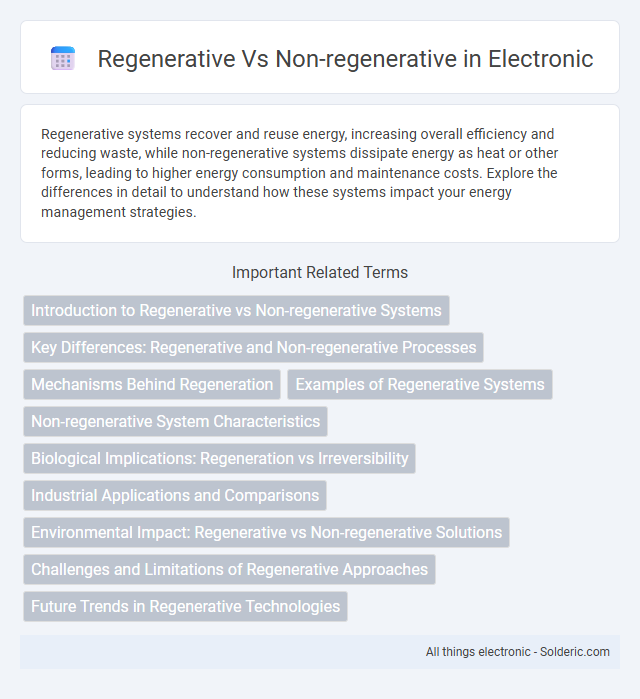Regenerative systems recover and reuse energy, increasing overall efficiency and reducing waste, while non-regenerative systems dissipate energy as heat or other forms, leading to higher energy consumption and maintenance costs. Explore the differences in detail to understand how these systems impact your energy management strategies.
Comparison Table
| Feature | Regenerative | Non-Regenerative |
|---|---|---|
| Definition | Systems that recover and reuse energy or materials. | Systems that waste energy or materials without recovery. |
| Energy Efficiency | High; recycles energy to reduce consumption. | Low; energy is dissipated and lost. |
| Environmental Impact | Reduces waste and carbon footprint. | Increases waste and emissions. |
| Examples | Regenerative braking in electric vehicles, composting. | Traditional braking systems, landfill waste disposal. |
| Cost Efficiency | Potentially lower long-term operational costs. | Lower initial cost but higher ongoing expenses. |
| Application Scope | Renewable energy, sustainable manufacturing. | Conventional energy systems, linear manufacturing. |
Introduction to Regenerative vs Non-regenerative Systems
Regenerative systems recover and reuse energy, enhancing efficiency and reducing waste in processes such as braking or heating. Non-regenerative systems, by contrast, dissipate energy as heat or other forms without reuse, leading to higher energy consumption and operational costs. Understanding these distinctions helps optimize your energy management strategies for sustainability and cost-effectiveness.
Key Differences: Regenerative and Non-regenerative Processes
Regenerative processes restore and reuse energy within a system, enhancing efficiency by capturing and recycling power, commonly seen in regenerative braking in electric vehicles. Non-regenerative processes dissipate energy as heat or other forms, without reclaiming it, typical in conventional braking systems where kinetic energy converts to thermal energy. The key difference lies in energy recovery and reuse, making regenerative processes more sustainable and cost-effective over time.
Mechanisms Behind Regeneration
Regenerative mechanisms involve specialized stem cells and signaling pathways that activate tissue repair and regrowth, allowing damaged tissues or organs to fully restore their original structure and function. Non-regenerative healing primarily relies on scar formation where fibrotic tissue replaces the damaged area, often resulting in limited functionality or incomplete recovery. Understanding these mechanisms helps you appreciate the biological potential and limitations of tissue regeneration vs. repair.
Examples of Regenerative Systems
Regenerative systems include regenerative braking in electric and hybrid vehicles, which recapture kinetic energy and convert it into electrical energy stored in batteries. Solar photovoltaic systems paired with battery storage enable energy regeneration by capturing sunlight and storing excess power for later use. Wind turbines integrated with energy storage solutions also exemplify regenerative systems, transforming variable wind energy into a steady supply of electricity through advanced control and battery technologies.
Non-regenerative System Characteristics
Non-regenerative systems dissipate energy without recovering or storing it, leading to continuous power consumption during operation. These systems rely on simple designs with fewer components, resulting in lower initial costs but reduced energy efficiency. Common applications include basic braking mechanisms where energy dissipation through heat is acceptable and energy recovery is not necessary.
Biological Implications: Regeneration vs Irreversibility
Regenerative processes enable biological tissues to restore structure and function by activating cellular mechanisms that promote healing and growth, contrasting sharply with non-regenerative processes where damage leads to permanent loss of function or scarring. In living organisms, regeneration involves stem cell proliferation and differentiation, maintaining homeostasis and reducing degenerative consequences, while non-regenerative responses often result in irreversible tissue degradation and compromised physiological performance. Understanding these biological implications helps you appreciate the critical role of regenerative capacity in promoting long-term health and recovery.
Industrial Applications and Comparisons
Regenerative braking systems are widely utilized in industrial applications such as electric forklifts, cranes, and automated guided vehicles (AGVs) to enhance energy efficiency by recovering kinetic energy and reducing operational costs. Non-regenerative braking relies solely on friction, leading to higher energy consumption and increased wear on braking components, making it less suitable for industries prioritizing sustainability and cost savings. Comparing both, regenerative braking offers superior longevity and reduced maintenance, driving its preference in modern industrial automation and material handling equipment.
Environmental Impact: Regenerative vs Non-regenerative Solutions
Regenerative solutions enhance environmental health by restoring ecosystems, increasing biodiversity, and improving soil quality, while non-regenerative methods often lead to resource depletion, habitat destruction, and increased pollution. Your choice between these approaches directly impacts long-term sustainability, as regenerative practices promote carbon sequestration and resilience against climate change. Prioritizing regenerative options supports a healthier planet by reversing environmental damage rather than perpetuating degradation.
Challenges and Limitations of Regenerative Approaches
Regenerative approaches in medicine face challenges such as high costs, limited scalability, and variability in patient response due to complex biological processes. Unlike non-regenerative treatments, they require precise integration and functionality of new tissues, which can be hindered by immune rejection and incomplete cell differentiation. You must consider these limitations when evaluating regenerative therapies for clinical applications.
Future Trends in Regenerative Technologies
Future trends in regenerative technologies emphasize advancements in biomaterials, stem cell therapies, and 3D bioprinting, which aim to enhance tissue repair and organ regeneration. Innovations in gene editing and personalized medicine are driving more effective, patient-specific regenerative treatments. Integration of artificial intelligence and nanotechnology is expected to further optimize regenerative outcomes and accelerate clinical applications.
Regenerative vs Non-regenerative Infographic

 solderic.com
solderic.com